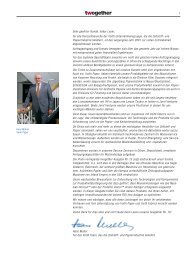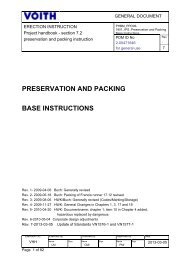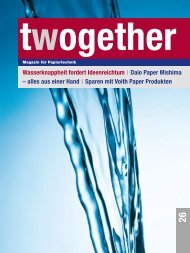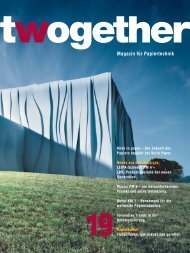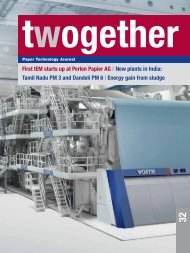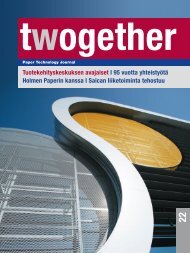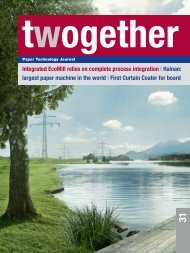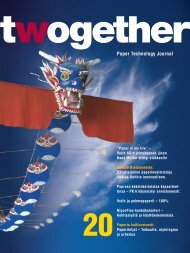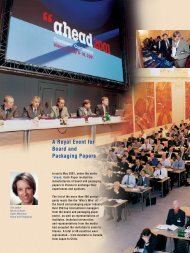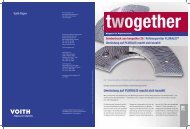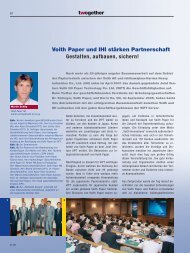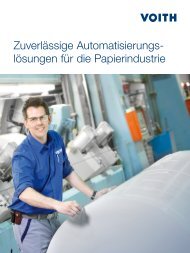Paper Technology Journal 19 - Voith
Paper Technology Journal 19 - Voith
Paper Technology Journal 19 - Voith
You also want an ePaper? Increase the reach of your titles
YUMPU automatically turns print PDFs into web optimized ePapers that Google loves.
● Number of nozzles<br />
● Nozzle spacing/nozzle width<br />
● One-sided dryer or double-sided<br />
floating dryer<br />
● Non-contact drying with simultaneous<br />
web turning (HCB-Turn).<br />
Consequently, any quality requirements<br />
relevant to the user can easily be incorporated<br />
during the project engineering<br />
phase. In this regard, the following aspects<br />
should be given special attention:<br />
● Level of heat transfer and drying rate<br />
● Avoidance of web overheating<br />
● Stability of the web run<br />
● Minimization of the open draws<br />
● Energy efficiency.<br />
Krieger CB-Dryers as components<br />
in coating color drying<br />
In many cases, a combination of infrared<br />
dryers, air dryers and drying cylinders is<br />
suitable for coating drying. The function<br />
of IR dryers is to heat the web to a high<br />
temperature as quickly as possible and<br />
simultaneously cause the evaporation of<br />
as much of the water contained in the<br />
coating as possible. Depending on the<br />
coating formulation, by incorporating a<br />
large percentage of IR drying, web temperatures<br />
can reach over 100 °C in the<br />
course of coating drying. For this reason,<br />
Krieger prefers to use air dryers from our<br />
series of CB-Dryers at this point in the in-<br />
stallation, because they allow for comparatively<br />
high drying rates at lower web<br />
temperatures.<br />
Next, the drying cylinders finish the remainder<br />
of the drying with the simultaneous<br />
possibility of correcting the curl of<br />
the paper or board web.<br />
With our different types of CB-Dryers,<br />
Krieger offers a modern air-drying system<br />
which, in addition to a uniform, noncontact<br />
web run, features highly efficient<br />
heat and mass transfer and maximum<br />
thermal stability. One of the main features<br />
of the Krieger CB-Dryers is the CB2<br />
hole-type nozzle, which permits the highest<br />
possible heat transfer rates. The development<br />
of this highly effective nozzle<br />
type is based both on fundamental insights<br />
into flow mechanics and on many<br />
years of experience in dealing with<br />
the special requirements of the paper<br />
industry.<br />
The development of the CB2 nozzle,<br />
therefore, aims not only at ensuring maximum<br />
heat transfer to the web, but also<br />
at obtaining optimized load capacity. In<br />
addition, it achieves the highest possible<br />
insensitivity to thermal deformation and<br />
contamination by coating color during<br />
sheet breaks.<br />
If air is blown onto the paper surface at a<br />
suitable angle at high velocity, vortices<br />
form in the air, thoroughly blending the<br />
Fig. 1: One-sided CB-Dryer, HCB-Turn and<br />
double-sided CB-Dryer.<br />
Fig. 2: Comparison of heat transfer coefficients<br />
in hole-type and slotted nozzles.<br />
Heat transfer coefficient [W/m2/K]<br />
350<br />
300<br />
250<br />
200<br />
150<br />
100<br />
50<br />
Hole-type nozzles<br />
Slotted nozzles<br />
61<br />
50 °C<br />
200 °C<br />
300 °C<br />
50 °C<br />
200 °C<br />
300 °C<br />
10 20 30 40 50 60 70 80<br />
Nozzle outlet velocity [m/s]<br />
drying air. This causes an increased heat<br />
exchange between core flow and paper<br />
surface. A measure of the number and intensity<br />
of these vortices, and thus also of<br />
the intensity of the heat transfer, is the<br />
so-called degree of turbulence. In addition<br />
to the air velocity and the direction<br />
of the approaching air flow, the nozzle<br />
shape is of major importance for the level<br />
of the degree of turbulence. Scientific<br />
studies have shown that hole-type nozzles<br />
have a distinct advantage over the<br />
simple, slotted nozzles. With the same<br />
air-flow rate (and the same required heating<br />
and fan capacity!), hole-type nozzles<br />
achieve up to 50 % higher heat transfer<br />
rates than slotted nozzles (Fig. 2).<br />
Furthermore, the CB2 nozzle ensures homogeneous<br />
heat transfer since, unlike<br />
slotted nozzles, a thermal change in the<br />
nozzle geometry is impossible. Through<br />
the use of materials with relatively low<br />
thermal expansion coefficients, a high<br />
<strong>19</strong>/05<br />
2



